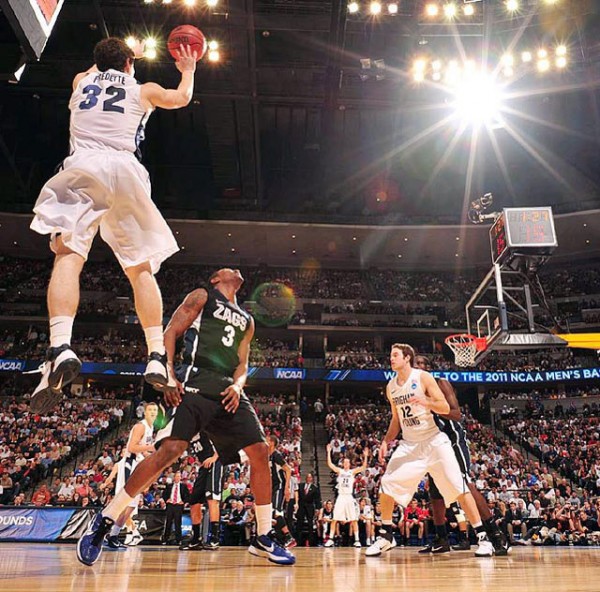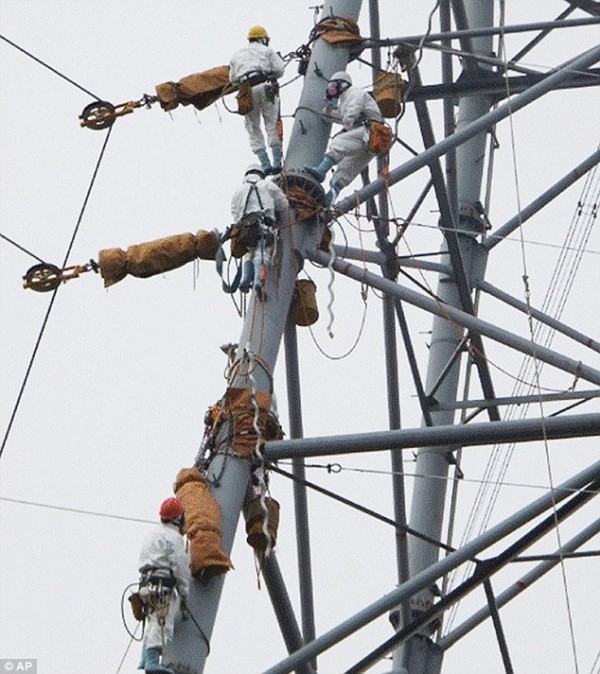Notes
(M)arch Madness
This week’s cover of Sports Illustrated features this photograph of Brigham Young University’s Jimmer Fredette releasing a long three-point jump shot over a Gonzaga Bulldogs’ defender in last week’s March Madness action. While the photo perfectly catches the beauty and grace of Fredette’s jump-shot (notice the elevation!), it also beautifully catches the complicated position of college sports in the American cultural landscape. Notice, in two opposing corners, the glaring domed-stadium light in the top right of the photograph and the rather over-familiar logo in the bottom left on the bottom of Fredette’s shoes.
While maybe not the NCAA game’s best all-around player (many question his defensive abilities), Fredette is the game’s best scorer and, this year, its most certifiable star. The light that shines from the top of the photograph is symbolic of the media glare NCAA sports draw. And the media glare, in the usual equation of American economics, equals considerable cash-flow. Outside the Super Bowl, the NCAA men’s basketball championships—March Madness—is the biggest sports draw on American television. The problem is none of the significant revenue derived from the event makes its way to the players who provide the madness (or not, at least, in any way sanctioned by the various NCAA rules committees).
Or maybe it’s not a problem. As I said, this illustrates the complicated cultural and, indeed, economic position of college sports in America. (In American, these are hardly separable.) Is this manipulation? Are these college athletes being exploited for their talents so that all sorts of corporations and institutional entities can make obscene amounts of money off what they do?—or do the opportunities afforded them by the college-athlete experience compensate them sufficiently for their being alienated economically from the activity that is the main focus of their young lives (all rhetoric about them being students first aside).
The logo on the bottom of Fredette’s shoe is of course the iconic swoosh of “Just Do It” fame, which, generally speaking, means just do what you have to do to make whatever money you can make. Student athletes are not allowed to sign endorsement or licensing contracts with corporate entities; their coaches and institutions, on the other hand, are allowed to sign as many lucrative offers as they can find.
Again, this raises complicated questions. Is this the kind of sponsorship that we want dominating the American university landscape? Frequently college basketball or football coaches at land-grant institutions are the highest paid public employees in the states they come from, reflecting the amount of revenue college sports generates. A coach who leads his basketball team deep into the NCAA tournament can make many times his salary in endorsement money. He may not earn any endorsements for ensuring his players graduate, but, in addition to his salary, a coach can draw paychecks leaping into the stratosphere for the sponsorship deals the institution signs with corporations hawking everything from sports drinks and foam number-1 fingers to, yes, these high visibility Chinese-made sneakers.
–Brent Cottle
(photo: Robert Beck /Sports Illustrated/Getty Images. caption: Brigham Young Jimmer Fredette (32) in action, taking shot vs Gonzaga Demetri Goodson (3) at Pepsi Center. Denver, CO 3/19/2011)



Reactions
Comments Powered by Disqus